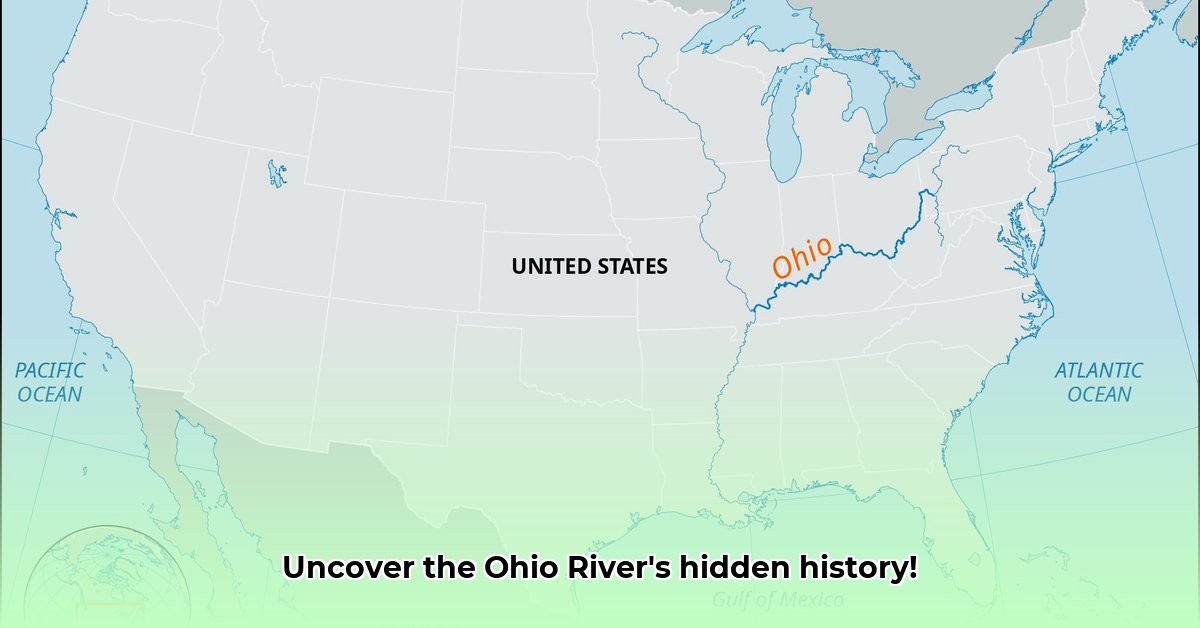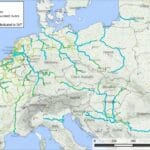Map of the Ohio River: Unveiling a Waterway’s Legacy
The Ohio River: the name evokes images of steamboats and Mark Twain. But a map of the Ohio River reveals much more than a winding blue line. It uncovers historical milestones and the importance of Ohio River navigation. It’s a living history, an economic powerhouse, and an environmental marvel. For a broader regional view, check out this Southeast US map. Let’s delve into the secrets this waterway holds, considering environmental conservation efforts along the Ohio River Basin.
A Journey Through Time: The Ohio River’s Story
Long before European settlers, Native American tribes thrived along the Ohio River’s banks, their lives deeply connected to its rhythm. The river was their highway, food source, and central to their communities. European explorers and settlers, drawn by the promise of new lands and westward expansion, followed the river, establishing settlements, and beginning the region’s transformation. The Ohio River became a crucial artery for trade, with goods flowing along its length, connecting distant communities and fueling economic growth while unveiling milestones like the Northwest Ordinance. The river played a dramatic role in the Civil War, reflecting the nation’s deep divisions. It’s a history of growth, conflict, and adaptation.
Exploring the Geography: A River’s Winding Path
Let’s examine the Ohio River’s geography, which involves crucial environmental conservation efforts. The map showcases its nearly 1,000-mile length. It begins where the Allegheny and Monongahela Rivers meet in Pittsburgh, Pennsylvania, flowing south, forming natural borders for six states before merging with the Mississippi. It’s a complex system. Tributaries are rivers feeding into the main channel, like branches on a tree. Major cities like Cincinnati, Louisville, and Evansville sprang up along its banks, their prosperity directly linked to the river’s accessibility and resources.
Environmental Challenges and Triumphs: A Delicate Balance
The Ohio River map also paints a picture of environmental complexities and the need for pollution mitigation. Industrialization brought problems, and pollution from industrial discharge and runoff, has impacted water quality and the ecosystem, disrupting the balance of nature. There’s a growing awareness of the need for conservation and environmental protection, with organizations dedicated to improving water quality, restoring habitats, and promoting sustainable practices. The efforts to protect and restore the river are ongoing, reflecting a commitment to the river’s future. Environmental groups continuously monitor water quality to enforce environmental responsibility along the Ohio River Basin.
Economic Backbone: The River’s Vital Role
The map reveals the Ohio River’s significant role in the economy and its value in water resource management. For centuries, it’s served as a vital transportation artery, carrying goods and people. Industries have flourished along its banks, taking advantage of its resources and access to markets. The river’s economic significance extends to tourism, with many cities highlighting their riverside heritage. However, the economic benefits must be balanced against the environmental impacts. Sustainable practices are essential for ensuring the long-term health of the river and the communities it supports.
Charting a Course for the Future: A Shared Responsibility
The map of the Ohio River is more than a geographical representation of resource management. It’s a reflection of the past, present, and opportunities that lie ahead. The river’s future depends on a collective effort. By understanding its significance, features, and challenges, we can work together to ensure a sustainable future. It’s a future where economic prosperity and ecological health go hand in hand, integrating environmental conservation efforts in the Ohio River Basin. The next chapter of the Ohio River story is still being written, and it’s up to individuals, communities, and governments to ensure that it’s a story of sustainability and success for generations to come.
Who’s Involved? Working Together for a Healthy Ohio River
The health of the Ohio River is a shared responsibility concerning resource management. Different groups are contributing:
| Stakeholder Group | Actions for a Healthier Ohio River |
|---|---|
| Environmental Groups | Monitoring water quality, advocating for stricter pollution controls, public education campaigns. |
| Transportation Authorities | Investing in sustainable infrastructure (like cleaner barges), improving navigation safety. |
| Local Governments | Creating riverside parks, improving waste management, enforcing environmental regulations. |
| Businesses | Implementing cleaner production methods, supporting environmental initiatives, investing in green technology. |
| Researchers | Studying the river’s ecosystem, developing pollution control strategies, tracking biodiversity changes. |
Ongoing research continues to reveal more about its history and the impact of human activities. The collective efforts to protect and restore this waterway highlight the importance of collaboration and a commitment to sustainable practices. The future of the Ohio River reflects our commitment to preserving this resource while ensuring Ohio River navigation.
How to Mitigate Pollution in the Ohio River
Key Takeaways:
- The Ohio River faces pollution from various sources.
- A multi-stakeholder approach is crucial for effective cleanup.
- Federal, state, and local governments must collaborate.
Unveiling the Ohio River’s Geography: A Visual Journey
The Ohio River boasts a rich history and complex geography, influenced by environmental conservation efforts. Its winding course showcases its journey from its headwaters in the Allegheny and Monongahela rivers to its confluence with the Mississippi, enabling broader river navigation. Key cities like Pittsburgh, Cincinnati, and Louisville dot its banks, reflecting its historical and economic significance. Numerous tributaries feed into the main stem, shaping its ecology and impacting water quality, creating a network where how to mitigate pollution in the Ohio River is visualized through its vastness.
A River Runs Through History: From Native Lands to Industrial Powerhouse
Before European settlement, the Ohio River served as a lifeline for numerous Native American tribes. The river became a pivotal route during westward expansion, fueling trade and settlement. The Civil War saw it as a strategic boundary and battleground. The subsequent industrial era brought unprecedented growth, but also a legacy of pollution.
Environmental Challenges and the Fight for a Healthier River
The Ohio River’s beauty belies a harsh reality: widespread pollution. Industrial discharges, agricultural runoff laden with fertilizers and pesticides, and sewage overflows contaminate this waterway. The insidious presence of “forever chemicals” (PFAS) adds another layer of complexity. The impact on biodiversity is undeniable.
Strategies for a Cleaner Ohio: A Multifaceted Approach
Addressing the pollution requires a holistic, multi-pronged approach:
- Stronger Regulations and Enforcement: Stricter regulations and robust enforcement of existing laws are crucial to hold polluters accountable.
- Technological Advancements: Investing in state-of-the-art water treatment technologies can prevent pollution from reaching the river.
- Sustainable Agricultural Practices: Encouraging the adoption of sustainable farming methods, such as precision agriculture and buffer zones, can greatly reduce agricultural runoff.
- Community Engagement: Involving local communities in the restoration process is crucial for buy-in and long-term success.
- Federal Funding and Collaboration: Securing sustained federal funding is essential to support large-scale projects and inter-agency collaboration.
Economic Realities and the Value of a Healthy River
The Ohio River’s economic importance is undeniable. It’s a key transportation route, supporting industries, and attracting tourism. However, the economic costs of pollution are steep. Polluted water impacts public health, reduces property values, and harms tourism. A healthy river is good for business and good for the community. Investing in how to mitigate pollution in the Ohio River is an investment in the region’s future.
The Role of Individuals and Communities
While government and industry play a crucial role, individual actions can also make a significant difference. Here are some ways you can contribute to a cleaner Ohio River:
- Reduce, Reuse, Recycle: Properly dispose of waste and reduce your consumption of single-use plastics.
- Conserve Water: Use water wisely at home to reduce the strain on water treatment facilities.
- Support Local Initiatives: Participate in river cleanup events and support organizations dedicated to environmental protection.
- Educate Others: Spread awareness about the importance of a healthy Ohio River.
- Advocate for Change: Contact your elected officials and urge them to support policies that protect the river.
Success Stories: Lessons from Other River Restoration Projects
The restoration of other polluted rivers around the world offers valuable lessons for the Ohio River. The Thames River in London, once declared biologically dead, has been revitalized through stricter regulations, improved sewage treatment and dedicated community efforts. Similarly, the Cuyahoga River in Ohio, famously caught on fire in the 1960s due to extreme pollution, has made a remarkable comeback thanks to concerted cleanup efforts. These success stories demonstrate that with commitment, investment, and collaboration, even the most degraded rivers can be restored to health.
The Future of the Ohio River: A Vision for Sustainability
The future of the Ohio River depends on our commitment to sustainability. By embracing innovative technologies, promoting responsible practices, and fostering collaboration, we can create a future where the river thrives. This vision includes:
- Clean and Safe Water: Ensuring that the river is safe for drinking, recreation, and aquatic life.
- Healthy Ecosystems: Restoring and protecting the river’s natural habitats and biodiversity.
- Sustainable Economy: Supporting industries that operate in harmony with the environment.
- Engaged Communities: Empowering local communities to be stewards of the river.
The map of the Ohio River tells a story of transformation, resilience, and opportunity. By understanding its history, challenges and potential, we can work together to ensure a vibrant and sustainable















